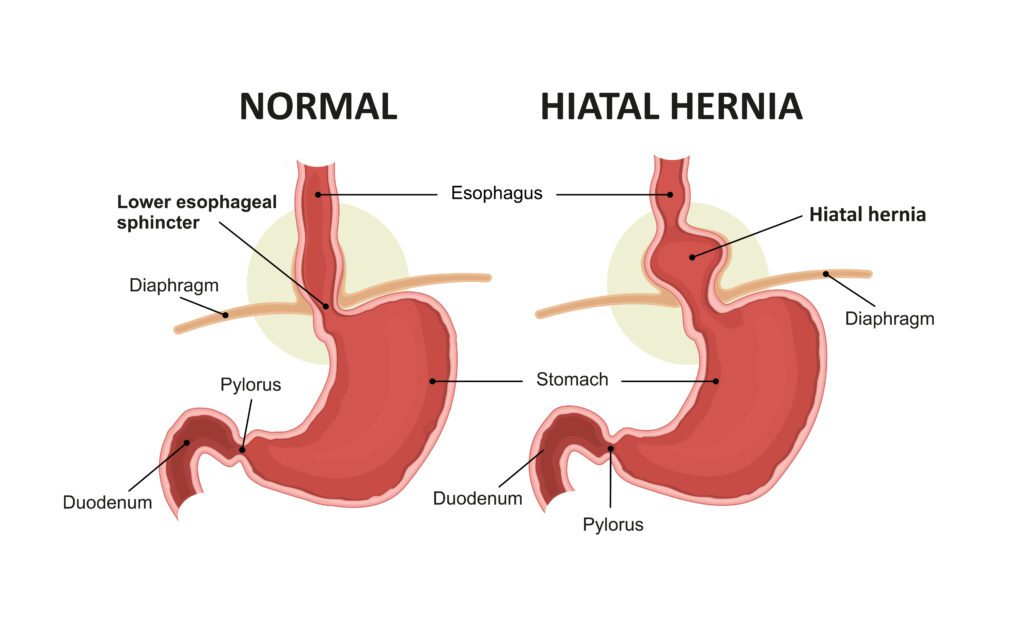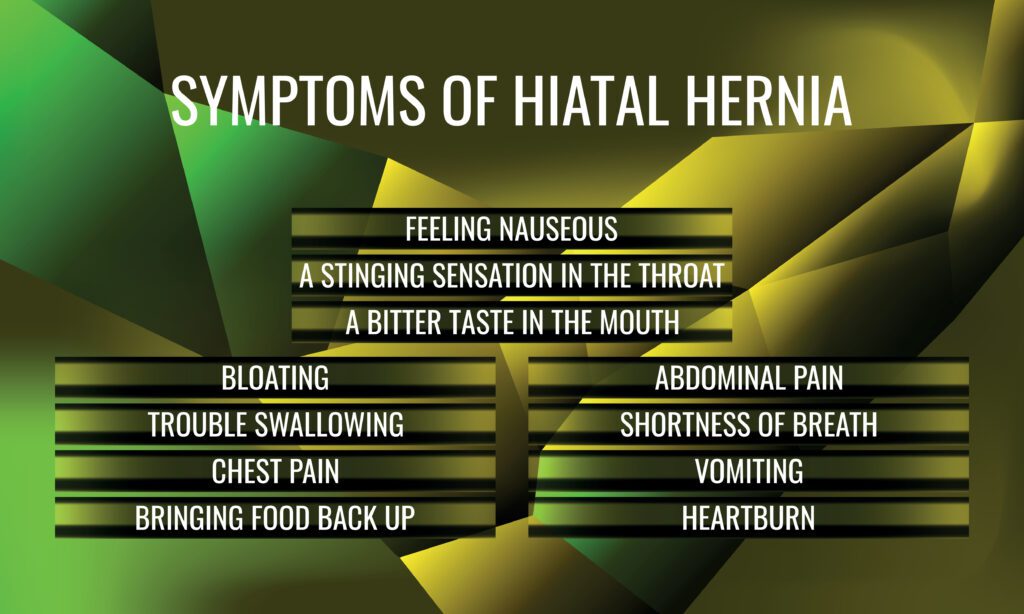In this guide, we’ll explore how to get a Hiatal Hernia VA Rating even if you’ve already filed or been denied VA benefits in the past.
VA Disability for Hiatal Hernia ranges from 10% to 60% with a break at 30%.
The highest scheduler VA Disability Rating for Hiatal Hernia is 60 percent, with symptoms such as:
- Hiatal Hernia with pain, vomiting, material weight loss and hematemesis or melena with moderate anemia; or other symptom combinations productive of severe impairment of health rate at 60%.
Your final VA Rating for Hiatal Hernia depends upon the Frequency, Severity, and Duration of symptoms to include and any impairment or loss (e.g., work/life impacts).
Pro Tip: Hernia conditions can be rated as high as 100 percent under other Diagnostic Codes (DCs). For example, under DC 7339 Hernia, Ventral, Postoperative, if a veteran has massive, persistent, severe diastasis of recti muscles or extensive diffuse destruction or weakening of muscular and fascial support of abdominal wall to be inoperable, rate at 100%.
Okay, let’s jump into this Insider’s Guide for getting a service connected disability rating for Hiatal Hernia as well as the 4 other types of ratable hernia conditions under the law.
- What is a Hiatal Hernia in Veterans?
- Common Signs and Symptoms of Hiatal Hernia:
- Hiatal Hernia VA Disability Rating: Basic Eligibility Criteria
- Can I Get VA Disability for Hiatal Hernia?
- How Do I Get a Hiatal Hernia VA Rating?
- What is the Reasonable Doubt Rule for Hiatal Hernia?
- What are the VA Disability Ratings for Hiatal Hernia?
- Can I Get a VA Rating for Other Types of Hernias?
- What Should I Expect at a VA C&P Exam for Hiatal Hernia?
- About the Author
What is a Hiatal Hernia in Veterans?

According to the Mayo Clinic, a Hiatal Hernia results when the upper part of your stomach expands through the large muscle separating your abdomen and chest (more commonly known as the diaphragm).
Your diaphragm has a small opening (called the “hiatus”) through which your food tube (esophagus) passes before connecting to your stomach.
If you have a Hiatal Hernia, your stomach pushes up through that opening and into your chest, which can allow food and acid to back up into your esophagus, leading to acid reflux, heartburn, and other painful symptoms.
Medications such as Omeprazole can help veterans relieve these symptoms.
A very large Hiatal Hernia could require surgery so be sure to talk to your doctor right away.
Common Signs and Symptoms of Hiatal Hernia:

A small Hiatal Hernia typically has no signs and symptoms.
However, a large Hiatal Hernia can cause painful signs and symptoms such as:
- Heartburn
- Backflow of stomach acid into the esophagus (acid reflux)
- Regurgitation of food or liquids into the mouth
- Trouble swallowing
- Chest or abdominal pain
- Feeling full right after you eat
- Shortness of breath
- Nausea
- Vomiting of blood or passing of black stools (gastrointestinal bleeding)
Hiatal Hernia VA Disability Rating: Basic Eligibility Criteria

To be eligible for a Hiatal Hernia VA Rating, a veteran must meet three (3) criteria by law:
- #1. Medical diagnosis of Hiatal Hernia, in a medical record (Service Treatment Records, VA medical records, or private medical records)
- #2. Your Hiatal Hernia was caused or made worse by your active-duty military service OR by another service connected disability for secondary service connection (“Nexus” for service connection)
- #3. Persistent and recurring symptoms of Hiatal Hernia (“Severity of Symptoms”) in terms of Frequency, Severity, and Duration to include any functional impairment or loss.
If you think you have a Hernia condition, but don’t have a medical diagnosis, pick-up the phone and call the VA health facility nearest you to make an appointment right away!
If you’re trying to increase your VA rating for Hiatal Hernia, you need to prove to the VA that your symptoms are now worse and warrant the higher rating criteria by law.
The #1 best way to increase your VA rating for Hiatal Hernia is to have objective medical evidence to show your symptoms have worsened over time.
Can I Get VA Disability for Hiatal Hernia?

Yes, you can get VA Disability for Hiatal Hernia with a rating of 10 percent, 30 percent, or 60 percent depending on your frequency, severity, and duration of symptoms.
The VA rates Hiatal Hernia under CFR 38, Part 4, VA Schedule of Ratings Diagnostic Code (DC) 7246, Hernia, Hiatal.
Note this is the same DC that the VA uses to rate GERD and other forms of epigastric distress by analogy.
According to our data, Hiatal Hernia is very common in veterans, and is the #40/50 most claimed VA disability condition.
How Do I Get a Hiatal Hernia VA Rating?

Generally, there are 3 ways a veteran can get a VA disability rating for Hiatal Hernia:
#1: Direct Service Connection for Hiatal Hernia with a rating of 10%, 30%, or 60%. This means an in-service event, injury, or disease related to your military service caused you to develop a Hiatal Hernia.
#2: Secondary Service Connection for Hiatal Hernia with a rating of 10%, 30%, or 60%. For example, a veteran can be rated for Hiatal Hernia secondary to PTSD.
#3: Service Connection by Aggravation for Hiatal Hernia with a rating of 10%, 30%, or 60%. For example, a veteran can be rated for Hiatal Hernia aggravated by “weight gain or obesity” as an interim link for service connection.
What is the Reasonable Doubt Rule for Hiatal Hernia?

The reasonable doubt rule, also known as the Benefit of the Doubt Doctrine, means that the evidence provided by the veteran must only persuade the decision maker that each factual matter is “at least as likely as not.”
This means there’s a 50/50 chance.
When, after careful consideration of all evidence, a reasonable doubt arises regarding service origin, the degree of disability, or any other point, such doubt will be resolved in favor of the veteran.
The courts further likened the reasonable doubt rule as akin to the principle in baseball that the “tie goes to the runner.”
When in doubt, the benefit is ALWAYS given to the veteran.
Independent providers and C&P examiners must consider and give weight to the veterans self-reported symptoms when completing their DBQ for Hiatal Hernia.
What are the VA Disability Ratings for Hiatal Hernia?

VA Ratings for Hiatal Hernia are either 10%, 30%, or 60%, depending on the frequency, severity, and duration of your symptoms:
- Hiatal Hernia with symptoms of pain, vomiting, material weight loss and hematemesis or melena with moderate anemia; or other symptom combinations productive of severe impairment of health rate at 60%.
- Hiatal Hernia with persistently recurrent epigastric distress with dysphagia, pyrosis, and regurgitation, accompanied by substernal or arm or shoulder pain, productive of considerable impairment of health rate at 30%.
- Hiatal Hernia with two or more of the symptoms for the 30% evaluation of less severity rate at 10%.
Can I Get a VA Rating for Other Types of Hernias?

Yes, there are 5 types of Hernias eligible for VA benefits under the law.
Femoral Hernia, DC 7340:
- Femoral Hernia (large), postoperative, recurrent, not well supported under ordinary conditions and not readily reducible, when considered inoperable rate at 60%.
- Femoral Hernia (small), postoperative recurrent, or unoperated irremediable, not well supported by truss, or not readily reducible rate at 30%.
- Femoral Hernia postoperative recurrent, readily reducible, and well supported by truss or belt rate at 10%.
- Femoral Hernia not operated on, but remediable rate at 0%.
- Femoral Hernia (small), reducible, or without true hernia protrusion rate at 0%.
Pro Tip: For VA rating purposes,Femoral Hernia and Inguinal Hernia are both rated under “Inguinal Hernia.”
Hiatal Hernia, DC 7346:
- Hiatal Hernia with symptoms of pain, vomiting, material weight loss and hematemesis or melena with moderate anemia; or other symptom combinations productive of severe impairment of health rate at 60%.
- Hiatal Hernia with persistently recurrent epigastric distress with dysphagia, pyrosis, and regurgitation, accompanied by substernal or arm or shoulder pain, productive of considerable impairment of health rate at 30%.
- Hiatal Hernia with two or more of the symptoms for the 30% evaluation of less severity rate at 10%.
Inguinal Hernia, DC 7338:
- Inguinal Hernia (large), postoperative, recurrent, not well supported under ordinary conditions and not readily reducible, when considered inoperable rate at 60%.
- Inguinal Hernia (small), postoperative recurrent, or unoperated irremediable, not well supported by truss, or not readily reducible rate at 30%.
- Inguinal Hernia postoperative recurrent, readily reducible, and well supported by truss or belt rate at 10%.
- Inguinal Hernia not operated on, but remediable rate at 0%.
- Inguinal Hernia (small), reducible, or without true hernia protrusion rate at 0%.
Pro Tip: Add 10 percent for bilateral involvement, provided the second hernia is compensable. This means that the more severely disabling hernia is to be evaluated, and 10 percent, only, added for the second hernia, if the latter is of compensable degree.
Muscle Hernia, DC 5326:
- Extensive Muscle Hernia, without other injury to the muscle, rate at 10%.
Ventral Hernia, DC 7339:
- Ventral Hernia with massive, persistent, severe diastasis of recti muscles or extensive diffuse destruction or weakening of muscular and fascial support of abdominal wall (inoperable) rate at 100%.
- Ventral Hernia (large), not well supported by belt under ordinary conditions rate at 40%.
- Ventral Hernia (small), not well supported by belt under ordinary conditions, or healed ventral hernia or post-operative wounds with weakening of abdominal wall and indication for a supporting belt rate at 20%.
- Ventral Hernia with wounds, postoperative, healed, no disability, belt not indicated rate at 0%.
Pro Tip: The Umbilical Hernia VA Rating falls under DC 7339, Ventral Hernia, with ratings of 0%, 20%, 40%, or 100%.
What Should I Expect at a VA C&P Exam for Hiatal Hernia?

A C&P exam for Hiatal Hernia involves a series of verbal questions, to include a physical examination, and sometimes diagnostic testing (if none have been performed) to include blood samples.
The following are a list of common questions asked at a VA C&P exam for Hiatal Hernia, based on the DBQ for Esophageal Conditions:
1A. DOES THE VETERAN NOW HAVE OR HAS HE OR SHE EVER BEEN DIAGNOSED WITH AN ESOPHAGEAL CONDITION?
Yes or no.
1B. WHAT IS THE VETERAN’S MEDICAL DIAGNOSIS?
- GASTROESOPHAGEAL REFLUX DISEASE (GERD)
- HERNIA HIATAL
- ESOPHAGUS, STRICTURE OF
- ESOPHAGUS, SPASM OF (cardiospasm)ESOPHAGUS, DIVERTICULUM OF, ACQUIRED
- OTHER ESOPHAGEAL CONDITION(S), specify: (such as eosinophilic esophagitis, Barrett’s esophagitis, etc.)
1C. IF THERE ARE ADDITIONAL DIAGNOSES THAT PERTAIN TO ESOPHAGEAL DISORDERS, LIST USING ABOVE FORMAT:
2A. DESCRIBE THE HISTORY (including onset and course) OF THE VETERAN’S ESOPHAGEAL CONDITIONS (brief summary):
2B. DOES THE VETERAN’S TREATMENT PLAN INCLUDE TAKING CONTINUOUS MEDICATION FOR THE DIAGNOSED CONDITION?
If “Yes,” list only those medications used for the diagnosed condition:
3. DOES THE VETERAN HAVE ANY OF THE FOLLOWING SIGNS OR SYMPTOMS DUE TO ANY ESOPHAGEAL CONDITIONS (including GERD)?
If “Yes,” check all that apply:
SYMPTOMS PRODUCTIVE OF CONSIDERABLE IMPAIRMENT OF HEALTH
SYMPTOMS COMBINATION PRODUCTIVE OF SEVERE IMPAIRMENT OF HEALTH
PERSISTENTLY RECURRENT EPIGASTRIC DISTRESS
INFREQUENT EPISODES OF EPIGASTRIC DISTRESS
DYSPHAGIA
PYROSIS
REFLUX
REGURGITATION
PAIN (Substernal, Arm, Shoulder)
SLEEP DISTURBANCE CAUSE BY ESOPHAGEAL REFLUX
If checked, indicate frequency of symptom recurrence per year: 1, 2, 3, 4 or more
If checked, indicate average duration of episodes of symptoms: Less than 1 day, 1-9 days, 10 days or more
MATERIAL WEIGHT LOSS
If checked, provide baseline weight: _______ and current weight: ________
(For VA purposes, baseline weight is the average weight for 2-year period preceding onset of disease)
NAUSEA
If checked, indicate frequency of episodes of nausea per year: 1, 2, 3, 4 or more
If checked, indicate average duration of episodes of nausea: Less than 1 day, 1-9 days, 10 days or more
VOMITING
If checked, indicate frequency of episodes of vomiting per year: 1, 2, 3, 4 or more
If checked, indicate average duration of episodes of vomiting: Less than 1 day, 1-9 days, 10 days or more
HEMATEMESIS
If checked, indicate frequency of episodes of hematemesis per year: 1, 2, 3, 4 or more
If checked, indicate average duration of episodes of hematemesis: Less than 1 day, 1-9 days, 10 days or more
MELENA WITH MODERATE ANEMIA
If checked, provide hemoglobin/hematocrit in diagnostic testing section
If checked, indicate frequency of episodes of melena per year: 1, 2, 3, 4 or more
If checked, indicate average duration of episodes of melena: Less than 1 day, 1-9 days, 10 days or more
4. DOES THE VETERAN HAVE AN ESOPHAGEAL STRICTURE, SPASM OF ESOPHAGUS (CARDIOSPASM OR ACHALASIA), OR AN ACQUIRED DIVERTICULUM OF THE ESOPHAGUS?
Yes or no.
6A. HAVE DIAGNOSTIC IMAGING STUDIES OR OTHER DIAGNOSTIC PROCEDURES BEEN PERFORMED?
Yes or no.
If yes, check all that apply:
- UPPER ENDOSCOPY Date and Results:
- UPPER GI RADIOGRAPHIC STUDIES Date and Results:
- ESOPHAGRAM (barium swallow) Date and Results:
- MRI Date and Results:
- CT Date and Results:
- BIOPSY, SPECIFY SITE: Date and Results:
- OTHER, SPECIFY: Date and Results:
6B. HAS LABORATORY TESTING BEEN PERFORMED?
If yes, indicate the type of testing and lap results.
6C. ARE THERE ANY OTHER SIGNIFICANT DIAGNOSTIC TEST FINDINGS AND/OR RESULTS?
If yes, provide type of test or procedure, date, and results (brief summary):
7. DO ANY OF THE VETERAN”S ESOPHAGEAL CONDITIONS IMPACT HIS OR HER ABILITY TO WORK?
If yes, describe impact of each of the veteran’s esophageal conditions, providing one or more examples:
About the Author

Brian Reese
Brian Reese is one of the top VA disability benefits experts in the world and bestselling author of You Deserve It: The Definitive Guide to Getting the Veteran Benefits You’ve Earned (Second Edition).
Brian’s frustration with the VA claim process led him to create VA Claims Insider, which provides disabled veterans with tips, strategies, and lessons learned to win their VA disability compensation claim, faster, even if they’ve already filed, been denied, gave up, or don’t know where to start.
As the founder of VA Claims Insider and CEO of Military Disability Made Easy, he has helped serve more than 10 million military members and veterans since 2013 through free online educational resources.
He is a former active duty Air Force officer with extensive experience leading hundreds of individuals and multi-functional teams in challenging international environments, including a combat tour to Afghanistan in 2011 supporting Operation ENDURING FREEDOM.
Brian is a Distinguished Graduate of Management from the United States Air Force Academy, Colorado Springs, CO, and he holds an MBA from Oklahoma State University’s Spears School of Business, Stillwater, OK, where he was a National Honor Scholar (Top 1% of Graduate School class).



